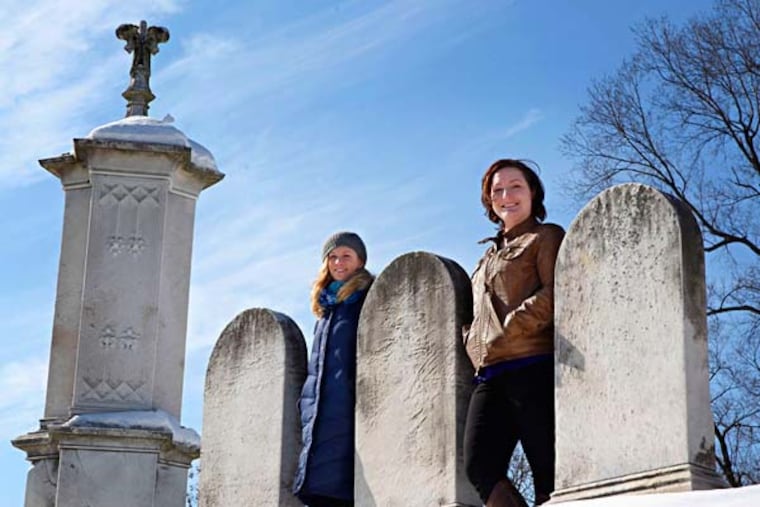Tales of erotica at Laurel Hill Cemetery
You wouldn't think there's much love or sex in a graveyard, but it turns out that Laurel Hill Cemetery has plenty of both.

You wouldn't think there's much love or sex in a graveyard, but it turns out that Laurel Hill Cemetery has plenty of both.
Like the Philadelphia banker's son who married one of America's most beautiful actresses. She dumped him.
And the devoted wife who had her heart - her real heart, not a paper cutout - buried next to her first husband. And the Union general who sent the Civil War equivalent of nude selfies to a lover who, after being spurned, published his private yearnings in a book.
Ah, love. Is anything more desired or celebrated?
During the last two years, Laurel Hill has turned Valentine's Day into more than a rush of roses and chocolates. It has developed themed programs based on the heartrending and occasionally heartless tales of some of the 75,000 people who rest in and upon its lawns.
Last year, the "Till Death Do Us Part" tour told stories of the lost, loved, and lustful. On Thursday, the cemetery offers a provocative, R-rated lecture on "Erotica and the American Civil War," proving that not for nothing does the name of Gen. Joseph Hooker live eternal.
"Sex is part of life. Why not a part of death?" said Kim Jovinelli, who will present the Civil War program with fellow researcher Lee Hood.
The goal? To help broaden public interest and support for Laurel Hill, set just off Kelly Drive on the east bank of the Schuylkill.
"We try to be risk-taking," said Gwen Kaminski, the cemetery director of development and programs.
Laurel Hill is among only a few cemeteries honored as a national historic landmark. It promotes itself as more than a burial ground, as an outdoor sculpture garden, educational resource, and genealogical archive. It must, because it has little room left for burials. Its future lies in its role as a resource - and a cool place to visit.
Laurel Hill attracts about 34,000 visitors a year. And holiday programs are popular.
Of course, many people connect Valentine's Day to the Civil War only in terms of tragic deaths, severed relationships, or flowery love letters. But erotica and the war were wed at the start by a relatively new technology: photography.
Entrepreneurs saw that the same process that enabled Mathew Brady to shoot pictures of great battlefields could also be used to capture images of naked women. Businessmen began mass-producing postcards that showed the barely dressed and undressed, women such as Adah Menken, an actress known as the Naked Lady.
Society was changing. Charles Goodyear had patented a process for vulcanization, helping create the first rubber condoms. The years after the war saw the invention of a device called the Manipulator, a steam-powered, coal-fired vibrator used by doctors to treat "female hysteria."
Wartime entrepreneur Thomas Ormsby distributed among troops a catalog called the "Private Circular for Gentlemen Only," which offered sex toys, photos, contraceptives, and condoms. Ormsby delivered his wares in a discreet box, the plain brown wrapper of its day.
Prostitution exploded during the war, as did the sale of potions to treat venereal diseases.
The trade and its consequences will be discussed Thursday, as will the story of Union officer and unintentional author Henry Morris Naglee, who lies near a low wall at Laurel Hill. During the war, he carried on a bawdy correspondence with a San Francisco woman named Mary Schell, then abruptly cut off contact, which proved regrettable.
She published his letters as a book, The Love Life of Brigadier General Henry M. Naglee.
He survived the scandal and, at 50, married 24-year-old socialite Marie Antoinette Ringgold. Naglee later was sued for breach-of-promise by his children's nanny, who claimed he had proposed marriage and then seduced her.
Last Valentine's Day, the love tour paused by the grave of Leonard Moorhead Thomas, the son of a prominent banker, who in 1910 married the glamorous actress Blanche Oelrichs.
She left him to marry the actor John Barrymore. That marriage ended, too.
None is together in death: Thomas is buried at Laurel Hill, Barrymore down the road in Mount Vernon Cemetery, and Oelrichs in New York.
Then there's the heart.
It beat in the breast of a woman named Mary Peterson, who in 1881 was vacationing in Atlantic City with her husband, Thomas. One night, he went for a walk and never returned. His body washed ashore four months later, his death a mystery.
Peterson eventually remarried. But she decreed that, upon her death, her heart be removed and buried next to her first husband at Laurel Hill. The rest of her was interred beside her second husband in a city churchyard.
"It was such a telling gesture of the meaning of love beyond life," Kaminski said. "If a story could symbolize why Valentine's could rightfully be celebrated in a cemetery, this was it."
Love Tour At Cemetery
"Erotica and the American Civil War," at 6:30 and 8 p.m. Thursday at Laurel Hill Cemetery gatehouse, 3822 Ridge Ave.
Lecture includes wine, cheese, and chocolate. Adults 21 and older, $20 per person.
Registration required at 215-228-8200 or www.thelaurelhill
cemetery.org.
Free parking
near the gatehouse.
EndText